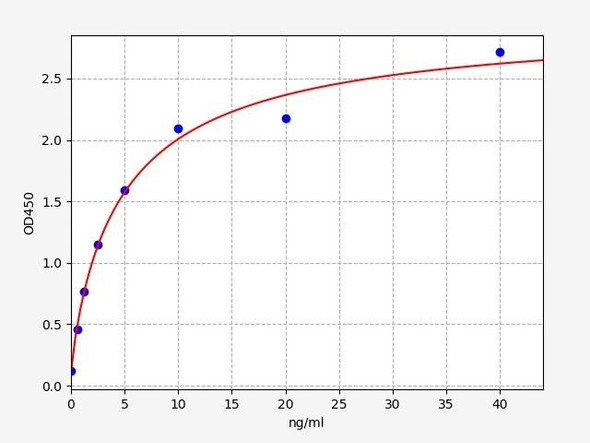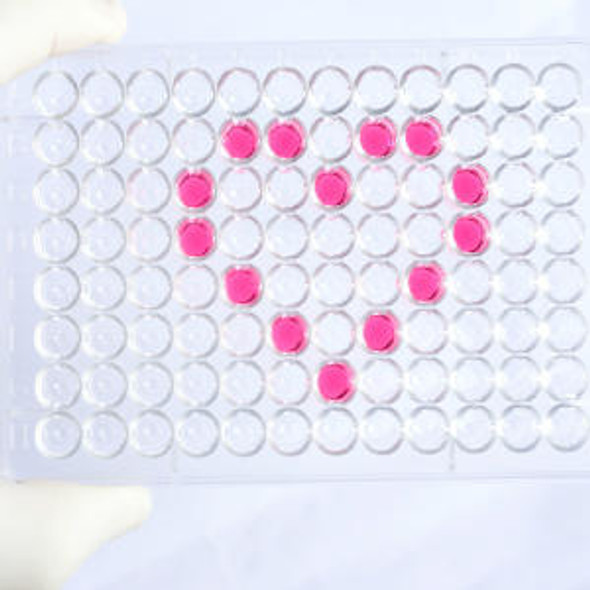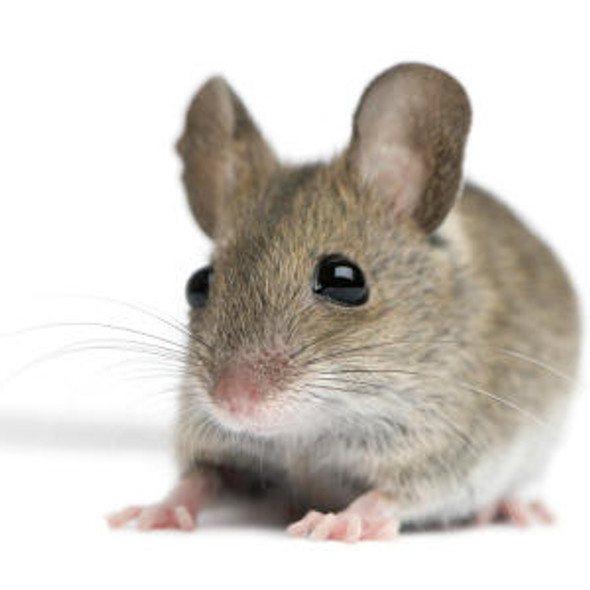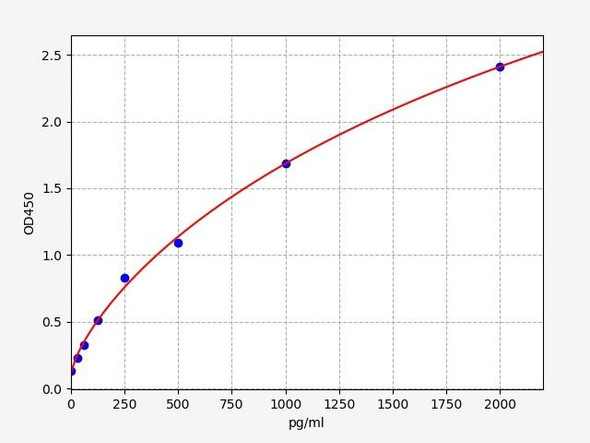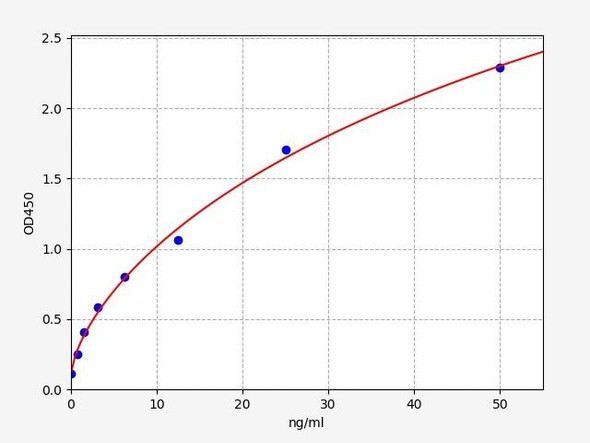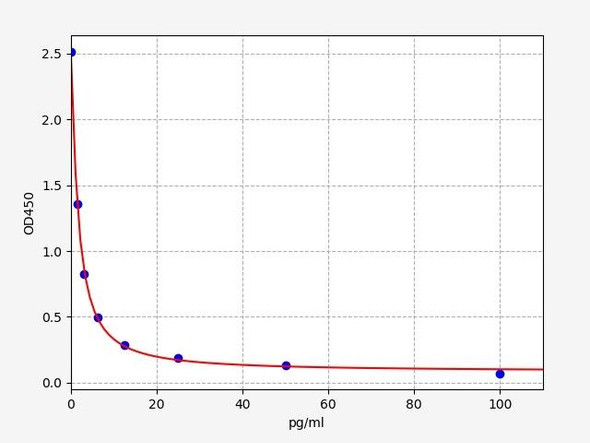Human CYP27B1 ELISA Kit
- SKU:
- HUFI00900
- Product Type:
- ELISA Kit
- Size:
- 96 Assays
- Uniprot:
- O15528
- Sensitivity:
- 0.469ng/ml
- Range:
- 0.781-50ng/ml
- ELISA Type:
- Sandwich ELISA, Double Antibody
- Synonyms:
- CYP27B1, VD3 1A hydroxylase, Cytochrome P450VD1-alpha, Cytochrome P450C1 alpha, Cytochrome P450 subfamily XXVIIB polypeptide 1, Calcidiol 1-monooxygenase, Cytochrome p450 27B1, 25-OHD-1 alpha-hydroxylase, 25-hydroxyvitamin D, 3 1-alpha-hydroxylase
- Reactivity:
- Human
Description
Human CYP27B1 ELISA Kit
CYP27B1 is a member of the cytochrome P450 superfamily of proteins. The cytochrome P450 enzymes are monooxygenases that catalyze several chemical transformations involved in drug metabolism and synthesis of cholesterol, steroids, and other lipids. CYP27B1 localizes to the inner mitochondrial membrane, where it hydroxylates 25-hydroxyvitamin D3 at the 1alpha position. CYP27B1 controls the amount of biologically active vitamin D and is essential for calcium homeostasis. Vitamin D-dependent rickets type I can be caused by mutations in this gene.
| Product Name: | Human CYP27B1 ELISA Kit |
| Product Code: | HUFI00900 |
| Size: | 96 Assays |
| Alias: | CYP27B1, VD3 1A hydroxylase, Cytochrome P450VD1-alpha, Cytochrome P450C1 alpha, Cytochrome P450 subfamily XXVIIB polypeptide 1, Calcidiol 1-monooxygenase, Cytochrome p450 27B1, 25-OHD-1 alpha-hydroxylase, 25-hydroxyvitamin D, 3 1-alpha-hydroxylase |
| Detection method: | Sandwich ELISA, Double Antibody |
| Application: | This immunoassay kit allows for the in vitro quantitative determination of Human CYP27B1 concentrations in serum plasma and other biological fluids. |
| Sensitivity: | 0.469ng/ml |
| Range: | 0.781-50ng/ml |
| Storage: | 4°C for 6 months |
| Note: | For Research Use Only |
| Recovery: | Matrices listed below were spiked with certain level of Human CYP27B1 and the recovery rates were calculated by comparing the measured value to the expected amount of Human CYP27B1 in samples. | ||||||||||||||||
| |||||||||||||||||
| Linearity: | The linearity of the kit was assayed by testing samples spiked with appropriate concentration of Human CYP27B1 and their serial dilutions. The results were demonstrated by the percentage of calculated concentration to the expected. | ||||||||||||||||
| |||||||||||||||||
| CV(%): | Intra-Assay: CV<8% Inter-Assay: CV<10% |
| Component | Quantity | Storage |
| ELISA Microplate (Dismountable) | 8×12 strips | 4°C for 6 months |
| Lyophilized Standard | 2 | 4°C/-20°C |
| Sample/Standard Dilution Buffer | 20ml | 4°C |
| Biotin-labeled Antibody(Concentrated) | 120ul | 4°C (Protect from light) |
| Antibody Dilution Buffer | 10ml | 4°C |
| HRP-Streptavidin Conjugate(SABC) | 120ul | 4°C (Protect from light) |
| SABC Dilution Buffer | 10ml | 4°C |
| TMB Substrate | 10ml | 4°C (Protect from light) |
| Stop Solution | 10ml | 4°C |
| Wash Buffer(25X) | 30ml | 4°C |
| Plate Sealer | 5 | - |
Other materials and equipment required:
- Microplate reader with 450 nm wavelength filter
- Multichannel Pipette, Pipette, microcentrifuge tubes and disposable pipette tips
- Incubator
- Deionized or distilled water
- Absorbent paper
- Buffer resevoir
| Uniprot | O15528 |
| UniProt Protein Function: | CYP27B1: Catalyzes the conversion of 25-hydroxyvitamin D3 (25(OH)D) to 1-alpha,25-dihydroxyvitamin D3 (1,25(OH)2D) plays an important role in normal bone growth, calcium metabolism, and tissue differentiation. Defects in CYP27B1 are the cause of rickets vitamin D- dependent type 1A (VDDR1A); also known as pseudovitamin D deficiency rickets (PDDR). A disorder caused by a selective deficiency of the active form of vitamin D (1,25- dihydroxyvitamin D3) and resulting in defective bone mineralization and clinical features of rickets. Belongs to the cytochrome P450 family. |
| UniProt Protein Details: | Protein type:Oxidoreductase; Mitochondrial; Lipid Metabolism - steroid biosynthesis; Cell cycle regulation; EC 1.14.13.13 Chromosomal Location of Human Ortholog: 12q14.1 Cellular Component: cytoplasm; mitochondrial outer membrane; mitochondrion Molecular Function:calcidiol 1-monooxygenase activity Biological Process: bone mineralization; calcium ion homeostasis; calcium ion transport; decidualization; negative regulation of cell growth; negative regulation of cell proliferation; positive regulation of keratinocyte differentiation; regulation of bone mineralization; response to estrogen stimulus; response to lipopolysaccharide; response to vitamin D; vitamin D metabolic process; vitamin metabolic process Disease: Vitamin D Hydroxylation-deficient Rickets, Type 1a |
| NCBI Summary: | This gene encodes a member of the cytochrome P450 superfamily of enzymes. The cytochrome P450 proteins are monooxygenases which catalyze many reactions involved in drug metabolism and synthesis of cholesterol, steroids and other lipids. The protein encoded by this gene localizes to the inner mitochondrial membrane where it hydroxylates 25-hydroxyvitamin D3 at the 1alpha position. This reaction synthesizes 1alpha,25-dihydroxyvitamin D3, the active form of vitamin D3, which binds to the vitamin D receptor and regulates calcium metabolism. Thus this enzyme regulates the level of biologically active vitamin D and plays an important role in calcium homeostasis. Mutations in this gene can result in vitamin D-dependent rickets type I. [provided by RefSeq, Jul 2008] |
| UniProt Code: | O15528 |
| NCBI GenInfo Identifier: | 3182968 |
| NCBI Gene ID: | 1594 |
| NCBI Accession: | O15528.1 |
| UniProt Secondary Accession: | O15528,Q548T3, B2RC61, |
| UniProt Related Accession: | O15528 |
| Molecular Weight: | 56,504 Da |
| NCBI Full Name: | 25-hydroxyvitamin D-1 alpha hydroxylase, mitochondrial |
| NCBI Synonym Full Names: | cytochrome P450 family 27 subfamily B member 1 |
| NCBI Official Symbol: | CYP27B1 |
| NCBI Official Synonym Symbols: | VDR; CP2B; CYP1; PDDR; VDD1; VDDR; VDDRI; CYP27B; P450c1; CYP1alpha |
| NCBI Protein Information: | 25-hydroxyvitamin D-1 alpha hydroxylase, mitochondrial |
| UniProt Protein Name: | 25-hydroxyvitamin D-1 alpha hydroxylase, mitochondrial |
| UniProt Synonym Protein Names: | 25-OHD-1 alpha-hydroxylase; 25-hydroxyvitamin D(3) 1-alpha-hydroxylase; VD3 1A hydroxylase; Calcidiol 1-monooxygenase; Cytochrome P450 subfamily XXVIIB polypeptide 1; Cytochrome P450C1 alpha; Cytochrome P450VD1-alpha; Cytochrome p450 27B1 |
| Protein Family: | 25-hydroxyvitamin D-1 alpha hydroxylase |
| UniProt Gene Name: | CYP27B1 |
| UniProt Entry Name: | CP27B_HUMAN |
*Note: Protocols are specific to each batch/lot. For the correct instructions please follow the protocol included in your kit.
Before adding to wells, equilibrate the SABC working solution and TMB substrate for at least 30 min at 37°C. When diluting samples and reagents, they must be mixed completely and evenly. It is recommended to plot a standard curve for each test.
| Step | Protocol |
| 1. | Set standard, test sample and control (zero) wells on the pre-coated plate respectively, and then, record their positions. It is recommended to measure each standard and sample in duplicate. Wash plate 2 times before adding standard, sample and control (zero) wells! |
| 2. | Aliquot 0.1ml standard solutions into the standard wells. |
| 3. | Add 0.1 ml of Sample / Standard dilution buffer into the control (zero) well. |
| 4. | Add 0.1 ml of properly diluted sample ( Human serum, plasma, tissue homogenates and other biological fluids.) into test sample wells. |
| 5. | Seal the plate with a cover and incubate at 37 °C for 90 min. |
| 6. | Remove the cover and discard the plate content, clap the plate on the absorbent filter papers or other absorbent material. Do NOT let the wells completely dry at any time. Wash plate X2. |
| 7. | Add 0.1 ml of Biotin- detection antibody working solution into the above wells (standard, test sample & zero wells). Add the solution at the bottom of each well without touching the side wall. |
| 8. | Seal the plate with a cover and incubate at 37°C for 60 min. |
| 9. | Remove the cover, and wash plate 3 times with Wash buffer. Let wash buffer rest in wells for 1 min between each wash. |
| 10. | Add 0.1 ml of SABC working solution into each well, cover the plate and incubate at 37°C for 30 min. |
| 11. | Remove the cover and wash plate 5 times with Wash buffer, and each time let the wash buffer stay in the wells for 1-2 min. |
| 12. | Add 90 µl of TMB substrate into each well, cover the plate and incubate at 37°C in dark within 10-20 min. (Note: This incubation time is for reference use only, the optimal time should be determined by end user.) And the shades of blue can be seen in the first 3-4 wells (with most concentrated standard solutions), the other wells show no obvious color. |
| 13. | Add 50 µl of Stop solution into each well and mix thoroughly. The color changes into yellow immediately. |
| 14. | Read the O.D. absorbance at 450 nm in a microplate reader immediately after adding the stop solution. |
When carrying out an ELISA assay it is important to prepare your samples in order to achieve the best possible results. Below we have a list of procedures for the preparation of samples for different sample types.
| Sample Type | Protocol |
| Serum | If using serum separator tubes, allow samples to clot for 30 minutes at room temperature. Centrifuge for 10 minutes at 1,000x g. Collect the serum fraction and assay promptly or aliquot and store the samples at -80°C. Avoid multiple freeze-thaw cycles. If serum separator tubes are not being used, allow samples to clot overnight at 2-8°C. Centrifuge for 10 minutes at 1,000x g. Remove serum and assay promptly or aliquot and store the samples at -80°C. Avoid multiple freeze-thaw cycles. |
| Plasma | Collect plasma using EDTA or heparin as an anticoagulant. Centrifuge samples at 4°C for 15 mins at 1000 × g within 30 mins of collection. Collect the plasma fraction and assay promptly or aliquot and store the samples at -80°C. Avoid multiple freeze-thaw cycles. Note: Over haemolysed samples are not suitable for use with this kit. |
| Urine & Cerebrospinal Fluid | Collect the urine (mid-stream) in a sterile container, centrifuge for 20 mins at 2000-3000 rpm. Remove supernatant and assay immediately. If any precipitation is detected, repeat the centrifugation step. A similar protocol can be used for cerebrospinal fluid. |
| Cell culture supernatant | Collect the cell culture media by pipette, followed by centrifugation at 4°C for 20 mins at 1500 rpm. Collect the clear supernatant and assay immediately. |
| Cell lysates | Solubilize cells in lysis buffer and allow to sit on ice for 30 minutes. Centrifuge tubes at 14,000 x g for 5 minutes to remove insoluble material. Aliquot the supernatant into a new tube and discard the remaining whole cell extract. Quantify total protein concentration using a total protein assay. Assay immediately or aliquot and store at ≤ -20 °C. |
| Tissue homogenates | The preparation of tissue homogenates will vary depending upon tissue type. Rinse tissue with 1X PBS to remove excess blood & homogenize in 20ml of 1X PBS (including protease inhibitors) and store overnight at ≤ -20°C. Two freeze-thaw cycles are required to break the cell membranes. To further disrupt the cell membranes you can sonicate the samples. Centrifuge homogenates for 5 mins at 5000xg. Remove the supernatant and assay immediately or aliquot and store at -20°C or -80°C. |
| Tissue lysates | Rinse tissue with PBS, cut into 1-2 mm pieces, and homogenize with a tissue homogenizer in PBS. Add an equal volume of RIPA buffer containing protease inhibitors and lyse tissues at room temperature for 30 minutes with gentle agitation. Centrifuge to remove debris. Quantify total protein concentration using a total protein assay. Assay immediately or aliquot and store at ≤ -20 °C. |
| Breast Milk | Collect milk samples and centrifuge at 10,000 x g for 60 min at 4°C. Aliquot the supernatant and assay. For long term use, store samples at -80°C. Minimize freeze/thaw cycles. |


